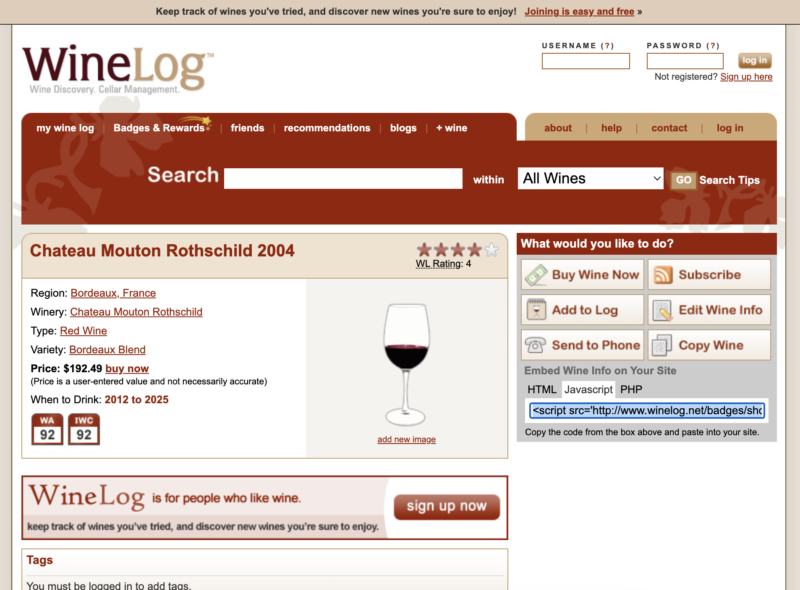WineLog.net was a social network and bottle tracking tool for wine drinkers. Jason and Kim launched WineLog at the start of the “Web 2.0” era of the Internet. It was a pretty standard idea, take an existing web tool and add tags and social elements to it. It worked well. The website got lots of traffic and attention and helped thousands of users learn more about wine. There were dozens of competitors.

The website worked well for about 6 years before being abandoned by us around 2012. We never found a way to make it commercially successful or sustainable. Some of the reasons for this are addressed in the lessons learned section below.
What now?
If you need a wine tracking tool, check out CellarTracker. When we started WineLog, CellarTracker was the largest cellar tracking site at the time. It probably still is the largest cellar tracking site. At one point CellarTracker was overly complicated and most useful for drinkers with physical wine cellars with dozens of wines stored. However, over the years, the site has modernized its user interface, made an excellent mobile app, and just generally stuck around and crushed it. We use CellarTracker ourselves now to keep track of a few special bottles we store at our house.
If you miss the wine blog, follow Ward Kadel (drXeNo, Vinopanion) on his blog, Twitter, or Instagram. Ward was our most prolific writer on the blog and continues to share stories about his wine adventures.
(If you used to write for WineLog and are still writing about wine elsewhere, let me know, and I will add links to your current project here.)
If you want more of Kim and Jason, checkout our podcast and subscribe to our newsletter.
Lessons Learned
WineLog was an important part of Stranger Studios history. We learned a ton that informed our future work and business.
On the technical side, we learned how to build complex apps with PHP. We learned how to maintain a project with thousands of lines of code. We learned that building a 2.0 version from scratch isn’t so easy. We like to gradually refactor bits and pieces as needed these days.
We learned how to build novel user interfaces. One of my proudest development moments was when WineLog made a list of top “AJAX” powered websites before we were using AJAX on the site. We just built a speedy and responsive UI, with the clever use of anchor tags, which made it feel like the whole page wasn’t reloading every time you searched or clicked to rate a wine.
We learned the power of SEO and content marketing. When WineLog launched we routinely were the first search result for small and large wine brands, with our pages often showing up above the winery’s own pages. We learned the pitfalls of relying on Google traffic when their own shopping results started being shown above the organic results and WineLog traffic got cut in half.
On the business side, we learned how to incorporate a business, how to budget, how to get free wine, and how to write off travel expenses.
We also learned the pitfalls of relying on business partners for your income. WineLog produced an incredible amount of traffic, and a lot of that traffic was looking to buy wine and would click on our “buy now” links. However, selling wine online was illegal for Pennsylvania companies and complicated for even the most dedicated of companies. So instead of selling wine ourselves, we would link out to third parties and collect various forms of referral fees.
We cycled through 3 different businesses that worked as middle men between our site and online wine shops. Each new partner took development time to integrate properly. All of those companies either went out of business or pivoted to different models themselves, leaving us looking for new ways to make money. Amazon started selling wine, which excited us because their selection was huge and their affiliate platform was easy to integrate with. Less than 3 months in, Amazon caved to legal pressures and stopped selling wine.
Our final play was to build the middle man ourselves. We built a tool that would figure out which online wine shops were selling which wines so we could properly route our “buy now” links. We kept track of the traffic we sent to each wine shop and then were basically going to reach out to them and ask for money or we would direct the traffic to a competitor. This time it was Google that reverse pivoted on us. Our Super Wine Search engine relied on the wine results in Google Shopping, the same results that were diverting our top line traffic. Google removed wine form their Google Shopping results, breaking our wine search engine, and effectively breaking our business. We had no more will power to pivot again, and our membership plugin for WordPress was starting to take off.
These days, we like businesses that solve problems for customers and get paid directly by those customers. And we do our best to avoid relying too heavily on one technology partner.
Overall, WineLog was a great experience for us.
We learned a ton. We learned how to appreciate good wine and how to pick it out at the wine shop. We learned how to build things on the web. We learned some lessons about partnerships, and how to focus on delivering for users.
We met a lot of awesome people. Thanks to everyone who used and supported WineLog. Thanks to everyone who wrote on our blog, bought ads on our site, and shared their tasting notes with us.
We doing great work now. It’s very fulfilling helping people and organizations to build better membership sites, to get paid and support their goals. But I wonder if we will ever work on something as viscerally “fun” as WineLog was.
